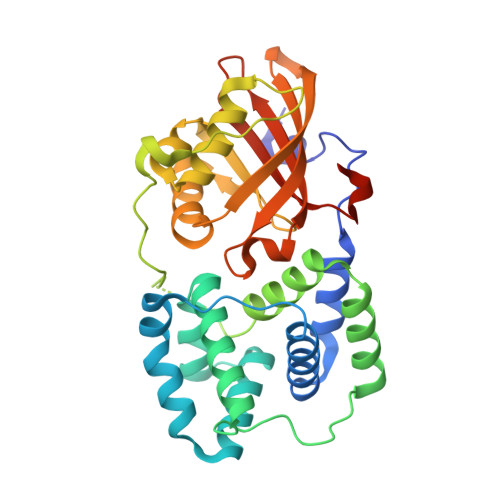Photoactivation mechanism of a carotenoid-based photoreceptor.
Bandara, S., Ren, Z., Lu, L., Zeng, X., Shin, H., Zhao, K.H., Yang, X.(2017) Proc Natl Acad Sci U S A 114: 6286-6291
- PubMed: 28559328
- DOI: https://doi.org/10.1073/pnas.1700956114
- Primary Citation of Related Structures:
5TUW, 5TUX, 5TV0 - PubMed Abstract:
Photoprotection is essential for efficient photosynthesis. Cyanobacteria have evolved a unique photoprotective mechanism mediated by a water-soluble carotenoid-based photoreceptor known as orange carotenoid protein (OCP). OCP undergoes large conformational changes in response to intense blue light, and the photoactivated OCP facilitates dissipation of excess energy via direct interaction with allophycocyanins at the phycobilisome core. However, the structural events leading up to the OCP photoactivation remain elusive at the molecular level. Here we present direct observations of light-induced structural changes in OCP captured by dynamic crystallography. Difference electron densities between the dark and illuminated states reveal widespread and concerted atomic motions that lead to altered protein-pigment interactions, displacement of secondary structures, and domain separation. Based on these crystallographic observations together with site-directed mutagenesis, we propose a molecular mechanism for OCP light perception, in which the photochemical property of a conjugated carbonyl group is exploited. We hypothesize that the OCP photoactivation starts with keto-enol tautomerization of the essential 4-keto group in the carotenoid, which disrupts the strong hydrogen bonds between the bent chromophore and the protein moiety. Subsequent structural changes trapped in the crystal lattice offer a high-resolution glimpse of the initial molecular events as OCP begins to transition from the orange-absorbing state to the active red-absorbing state.
Organizational Affiliation:
Department of Chemistry, University of Illinois at Chicago, Chicago, IL 60607.
















